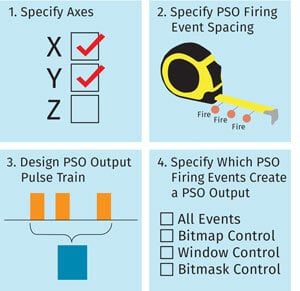
Trigger your process tool based on distance traveled, avoiding trigger errors based on acceleration, deceleration, or any other velocity instability
Integrates well with fast-pulsed lasers, enabling next-generation display and medical device manufacturing
Includes versatile, process-enhancing features
Aerotech's Position Synchronized Output (PSO) feature coordinates your motion with output that triggers lasers or data acquisition devices for high-speed, high-quality, and unparalleled process control.
Use programmed analytical velocity as the tracking input for triggering the PSO output. With new Part-Speed PSO, the ability to trigger the PSO output based upon real encoder feedback is now extended to the part-space vector velocity command.
Part-Speed PSO allows:
Control of the PSO output based on your process tool's part-processing velocity, even when kinematic mechanical arrangements are used
Control of the PSO output when using non-linear opto-mechanical axes, such as 3D galvo scanners
PSO control with reduced wiring complexity
Why control your process based on velocity when you really care about position? Aerotech’s control solutions can fire position-calculated PSO pulses at up to 12.5 MHz and with latencies as low as 80 nanoseconds. You can use these pulses to trigger a laser, sensor, camera, or other devices that accept IO. As processes become more dependent on accuracy and throughput, firing based on actual part position becomes more important. PSO pulses can be commanded on up to three axes of vector motion while tracking the calibrated feedback at high-speeds and low latencies.
Laser technology is constantly evolving, and fast-pulsed lasers are enabling new material processing capabilities. These processes often include the use of fast-pulse or short-pulse lasers. PSO is a differentiating controller feature for these processes because no other control technology allows the sub-micrometer accuracy of laser spot placement without sacrificing throughput. Even at high accelerations, thermal management is possible. Additionally, PSO has long been enjoyed by laser cutting and laser welding applications. These applications include the use of CO2, YAG, and excimer fiber lasers.
PSO’s versatility is defined not only by its low latency and high frequency, but also by the several modes of operation that enable precise integration with many processes. Keep reading to learn more about how PSO works.
PSO set-up is easy. A 4-step process is implemented in Aerotech’s AeroBasic conversational programming language.
Specify which axes are involved in your vector-based distance calculation
Specify the spacing of the PSO firing event
This can be specified as: Fixed distances across your part
Custom fire-to-fire event distances loaded to a data array
Design the PSO output pulse train required at each firing event
Specify which PSO firing events create PSO outputs from the drive hardware; PSO outputs can be specified such that:
They occur at all PSO firing events
PSO firing events become PSO outputs based on binary data array values
Only when the specified axes are within a certain position-based window
The duty-cycle of the PSO output pulse train is modified based on a grayscale array value
Most methods of specifying PSO firing events and PSO outputs can be mixed and matched to optimize your application’s requirements.
Figure 1. Aerotech’s Position Synchronized Output can be implemented in four easy steps.
At each PSO firing event, represented by the red dot in each image, a PSO output pulse train is generated but not necessarily output by the drive hardware. When a PSO output pulse is called for, the drive will output the PSO output pulse train as specified. Several cycles can be involved in a pulse train, depending upon your application’s requirements. The amplitude of the PSO output is dependent on the voltage level connected to the PSO circuit. The ability to modify the on/off behavior and amplitude of pulsing makes PSO the most flexible position-based tool command available to high-end, precision processes.
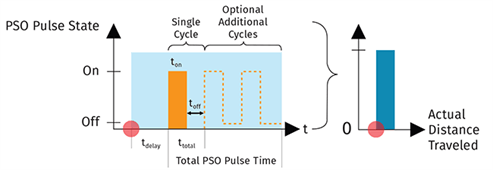
Figure 2. A PSO pulse train specifies the on/off behavior of the PSO output. A PSO pulse train occurs every time the controller generates a PSO firing event and is specified by a total time, an “on” time, a number of cycles, and delay time (from the PSO firing event). The behavior of this PSO output pulse train can be thought of as a single “event”, represented by the darker blue bar on the right-hand-side of the image.
Fixed-Distance PSO pulsing is the most common use case for PSO. This is because firing based on position feedback is the most accurate way to ensure critical process control, such as laser firing or data acquisition, occurs where you intend. In this mode:
The fixed-distance spacing of firing events is specified by the user.
Up to three axes of encoder feedback can be used to calculate the actual distance traveled.
At each PSO firing event, the user-specified PSO output pulse train is generated.
The PSO output pulse train becomes the PSO output at each PSO firing event.

Figure 3. The red dots represent PSO firing events generated at a fixed distance by the PSO distance counter. The blue bars represent a PSO output pulse train generated by the pulse generator. In this example, the user is generating a PSO output at each PSO firing event. Therefore, the specified PSO output pulse train is output at the drive hardware every time the distance counter creates a PSO firing event.
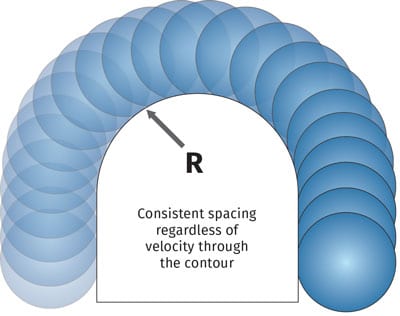
Figure 4. A highlight of fixed-distance firing is that changes in velocity (acceleration) do not affect your pulse-to-pulse laser spacing. This type of control increases part quality and throughput in high-dynamic precision processes.
Another common mode for PSO is to specify which fixed-distance PSO firing events create an actual PSO output through the use of data array values. In this mode:
The fixed-distance spacing of firing events is specified by the user.
An on/off sequence of desired PSO outputs is created and downloaded to the drive hardware.
Up to three axes of encoder feedback can be used to calculate the actual distance traveled.
At each PSO firing event, the user specified PSO output pulse train is generated.
The PSO output pulse train becomes the PSO output based on the on/off sequence on the drive hardware.
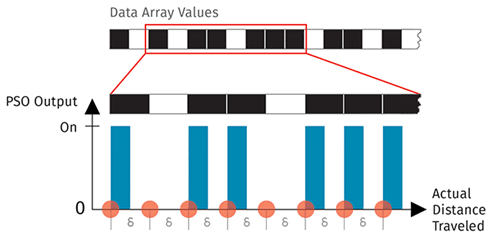
Figure 5. Bitmap firing is represented in this image. In this PSO output mode, array values are indexed through as PSO firing events occur. The array values are used to specify which PSO firing events result in a PSO output at the drive. In this implementation, the distance counter still tracks the same spacing between events, but commands your process tool at specified locations.
Used for applications such as grayscale laser marking, this PSO mode combines the array-based method above with control of the duty cycle of the PSO output pulse train. In this mode:
The fixed-distance spacing of firing events is specified by the user.
An on/off sequence of desired PSO outputs is created and downloaded to the drive hardware. Additionally, each on/off value has a duty-cycle value associated with it, which is also downloaded to the hardware.
Up to three axes of encoder feedback can be used to calculate the actual distance traveled.
At each PSO firing event, the user specified PSO output pulse train is generated. The PSO output pulse train becomes the PSO output based on the on/off sequence on the drive hardware.
The PSO output pulse train is modified based upon the associated duty-cycle value.
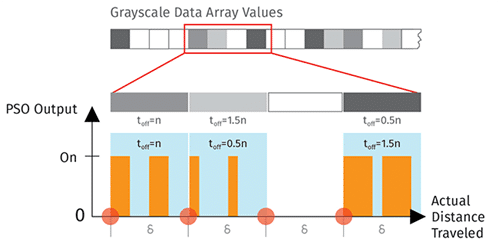
Figure 6. Grayscale or “Bitmask” firing is represented in this image. In this PSO output mode, array values are indexed through as PSO firing events occur. The array values are used to specify which PSO firing events result in a PSO output at the drive. Additionally, analog or “grayscale” values are used to control the duty cycle of the specified PSO output pulse train. In this implementation, the distance counter still tracks the same spacing between events, but commands your process tool at specified locations.
In addition to on/off and grayscale output control, you can specify position-based windows. Use these windows in applications that require pulsing only take place in certain specified position ranges. The fixed-distance, array-based on/off, and array-based grayscale control are all available in combination with window control. To use window control:
The user specifies the window range and enables window operation.
PSO is used as per the above modes.
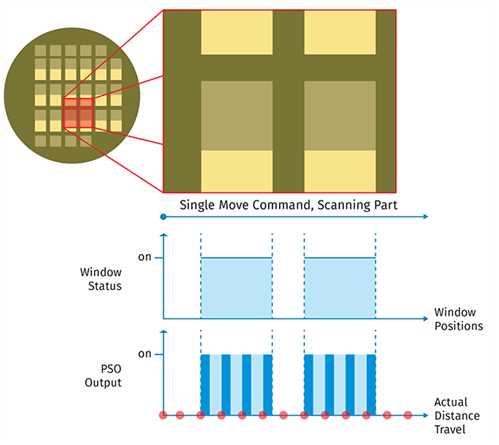
Figure 7. In this example, windows are established that mask the PSO output unless the tool is in the specified window ranges. PSO firing events (represented by the red dots on the bottom graph) occur outside of the window ranges. However, PSO outputs (represented by the blue bars) do not occur unless within the specified position-based windows.
When implementing any of the above modes, you can use custom PSO firing event-to-event spacing. You can specify custom spacing values for applications where constant spacing is not required.
Aerotech customers use PSO to trigger processes that include:
Laser firing
Camera capture
Data acquisition
Nondestructive test triggering
PSO's versatility services many noteworthy precision manufacturing processes, including:
Laser Cutting Stents and Other Interventional Cardiac Devices
Processing of Turbine-Blade Holes
Fuel Injector Drilling
Synchronizing Position Synchronized Output (PSO) with Mode Locked Lasers
A3200 Product Feature Highlight: Position Synchronized Output (PSO)
Laser Raster-Scanning Patterns on Cylindrical Workpieces Using CADFusion and PSO Bitmap Tools